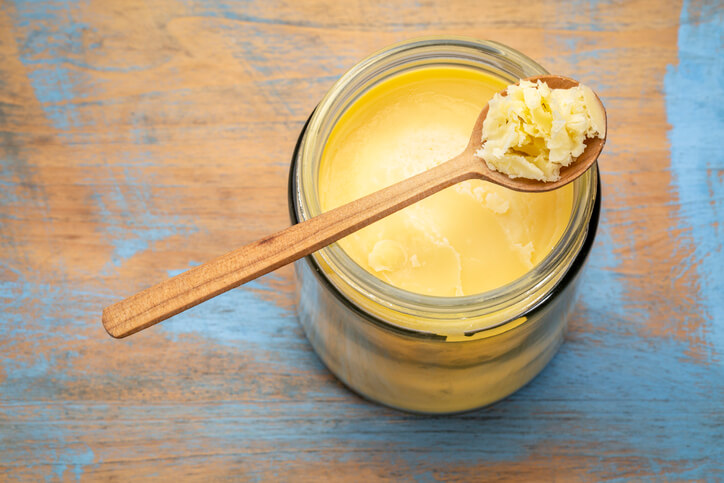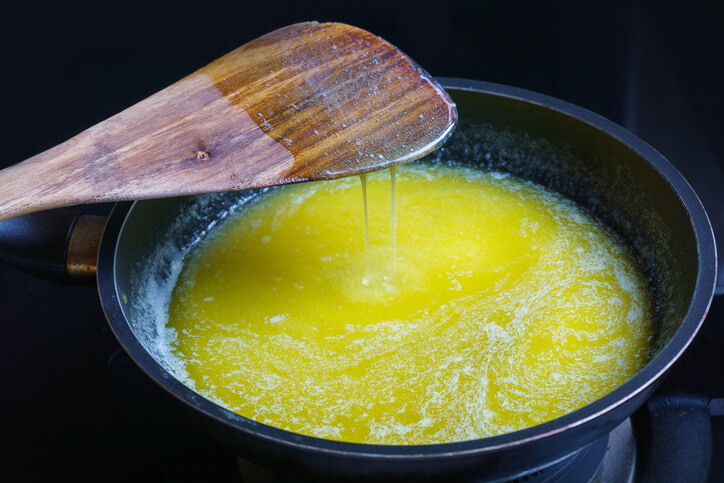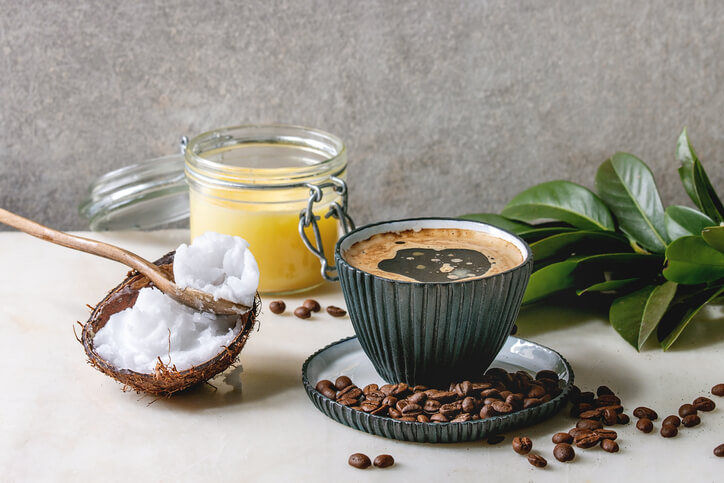Do you use ghee in your diet? It’s the yogi’s perfect source of healthy fat, given that it comes from India and makes its way into the vast treasure trove of healing recipes found in Ayurveda.
Traditionally made from the milk of the sacred cow, ghee is also said to have therapeutic benefits, having been used in Ayurveda to aid in digestion and act as an anti-inflammatory healing agent for centuries.
The nutty-tasting clarified butter has also found a home within trendy ketogenic diet circles, as a healthy, lactose-free fat with which to start your day, and popular ingredient in ‘bulletproof’ coffee.
While you can readily find ghee at your local health food store, you can also make it at home.
The DIY version is a meditative process in and of itself, and a lovely little addition to your mindfulness practice in the kitchen.
What is Ghee?
Simply put, ghee is a butter—one that’s been clarified. The clarification process consists of straining the butter of its liquid.
But, ghee is no ordinary clarified butter.
It has a different flavor profile than traditional clarified butter because ghee is slightly caramelized, which gives it a distinctively nutty flavor.
Unlike the clarified butter of France, for example, that has a sweet and smooth flavor, ghee is cooked slowly, giving it a chance to brown. Hence, the nutty flavor.

The cool thing about ghee is the fact that people with dairy sensitivities can typically eat it without problem.
Why? Because in the process of clarifying the butter, lactose and casein are gently removed. These are two ingredients that trigger those dairy allergies and sensitivities.
What’s more, ghee is shelf stable because of its absence of water. It also has a higher smoking point than butter, meaning you can cook it at a higher heat before it oxidizes.
Ghee also contains healthy omega-3 fatty acids, and also something known as butyric acid, known to be good for digestion.
All that said, ghee is a fantastic staple to have in your yogi pantry, and you should definitely consider making it at home! (Learn more in 5 Ayurvedic Recipes to Stoke Your Inner Fire.)
How Do You Make Ghee?
To make this pantry staple at home, you really don’t need much in terms of kitchen tools or even experience.
The first step involves butter and a skillet. Opt for a high-quality, organic butter.
You may want to experiment with cultured and uncultured butter. Both are good.

You’re simply going to melt the butter over medium-low heat.
After a few minutes, you’re going to see the butter separate into three different parts. You’ll see a layer of foam on top, the milk solids on the bottom, and the clarified butter in the middle, between the two. The milk solids at the bottom should turn a light brown.
Allow the butter layer in the middle to simmer until it becomes fragrant. It should also turn to a lovely golden hue, while the milk solids below become brown.
This is the process of caramelization that make ghee taste so good. If you’re clarifying a pound of butter, expect the process to take approximately 45 minutes.
Allow more time if you’re making an even bigger batch. And allow even more time if you want the solids to caramelize further. You get to decide how brown you want them.
The next step involves skimming the foam off the top.
Just place that foam into a bowl and turn off your heat. Strain the middle layer—the golden clarified butter layer through a strainer and into a glass jar, leaving the brown milk solids in the skillet.
The layer in your jar is the ghee!
You can throw the browned milk solids away, or enjoy them in a simple meal of brown rice.
Some of Ghee’s Delicious Uses
Ghee can be used both internally and externally. It’s uses are endless!
In the morning, blend a tablespoon of ghee in your coffee for a healthy morning beverage. (Learn more in Fill Your Mind, Body and Soul: A Morning Ritual to Start Your Days.)

Use it as a cooking oil. Ghee has a high smoking point, which makes it more versatile than other cooking oils.
Spoon it into oatmeal, or on toast.
Enjoy it in exactly the way you would butter. Use it as a finishing element, as a final touch or condiment in any vegetarian dish.
In India, ghee is used to toast spices. The spices become aromatic when toasted, before adding them to your meal.
As ghee is full of vitamins, it’s great for healing chapped lips or dry skin. You can even use ghee as a body moisturizer and/or massage oil.
Ghee is truly versatile and good for you—inside and out!
Of course, you can always skip the time-intensive process of making it at home, and simply buy an organic version at your local health food store or online.
It’s obviously more expensive than butter, and for good reason. Its creation is time and labor intensive when compared to butter. But, give it a shot! (Learn more in Mindful Consumption for a Joyful New Year.)
You may find it to be the perfect staple for you and your family!
During These Times of Stress and Uncertainty Your Doshas May Be Unbalanced.
To help you bring attention to your doshas and to identify what your predominant dosha is, we created the following quiz.
Try not to stress over every question, but simply answer based off your intuition. After all, you know yourself better than anyone else.